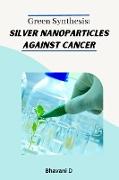Green synthesis: silver nanoparticles against cancer
BücherAngebote / Angebote:
Green synthesis of silver nanoparticles from natural plant extracts is an environmentally friendly and sustainable approach. In recent years, this approach has gained attention due to its potential to develop nanomaterials that can be used in various applications, including medicine. Among these, the use of silver nanoparticles has shown promising results in cancer treatment.
Guazuma ulmifolia, commonly known as the West Indian elm, is a tree that grows in tropical regions of Central and South America. Its leaves and bark have been used in traditional medicine to treat various ailments, including cancer. Researchers have investigated the potential of Guazuma ulmifolia extracts in the green synthesis of silver nanoparticles.
The green synthesis process involves the use of plant extracts as reducing agents and stabilizers for the synthesis of nanoparticles. The extracts are mixed with silver ions, and the reduction process takes place in a controlled environment. The resulting silver nanoparticles are characterized by various techniques, including UV-Vis spectroscopy, transmission electron microscopy (TEM), and X-ray diffraction (XRD).
The synthesized silver nanoparticles from Guazuma ulmifolia extracts have shown remarkable potential in cancer treatment. Several studies have reported their effectiveness in inhibiting the growth of cancer cells, inducing cell death, and reducing tumor size in animal models.
The mechanism of action of silver nanoparticles against cancer cells is not yet fully understood. However, it is believed that they can induce oxidative stress and damage to the cancer cell membrane, leading to cell death. Silver nanoparticles can also interact with proteins and enzymes involved in cancer cell proliferation and metastasis, inhibiting their activity.
The use of silver nanoparticles in cancer treatment has several advantages over traditional chemotherapy. First, silver nanoparticles can selectively target cancer cells while sparing healthy cells, reducing the side effects of treatment. Second, they can overcome the resistance of cancer cells to chemotherapy drugs, making them a promising alternative or complement to current therapies. Third, silver nanoparticles can be easily functionalized with targeting molecules, such as antibodies or peptides, to increase their specificity towards cancer cells.
In conclusion, the green synthesis of silver nanoparticles from Guazuma ulmifolia extracts has shown promising results in cancer treatment. The use of natural plant extracts as reducing agents and stabilizers for the synthesis of nanoparticles is a sustainable and environmentally friendly approach. Silver nanoparticles have the potential to overcome the limitations of current cancer therapies and improve patient outcomes. However, further research is needed to fully understand their mechanism of action and optimize their effectiveness and safety.
Folgt in ca. 15 Arbeitstagen


